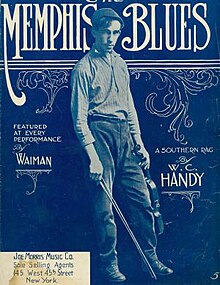メンフィス・ブルース (曲)
| 「ザ・メンフィス・ブルース」 | |
|---|---|
 1912年出版の楽譜の表紙。 | |
| 楽曲 | |
| リリース | 1913年11月10日 (1913-11-10) ニューヨーク Theron C. Bennett Co.[1] |
| 規格 | 楽譜 |
| ジャンル | サザン・ラグ |
| 作曲者 | W・C・ハンディ |
| 「ザ・メンフィス・ブルース」 | |
|---|---|
| ビクター・ミリタリー・バンド (Victor Military Band) の シングル | |
| リリース | |
| 規格 | 78回転盤 |
| 録音 | 1914年7月15日 (1914-07-15)[3] ニュージャージー州カムデン ビクター・スタジオ |
| ジャンル | サザン・ラグ、ブルース |
| 時間 | |
| レーベル | Victor 17619 |
| 作詞 | ジョージ・A・ノートン |
| 作曲 | W・C・ハンディ |
| テンプレートを表示 | |

「メンフィス・ブルース」(Memphis Blues) としてしばしば言及される[4][5]、「ザ・メンフィス・ブルース」(The Memphis Blues) は、作曲者W・C・ハンディ(英語版)自身が「サザン・ラグ (southern rag)」の作品とした楽曲。この曲は、1912年9月にハンディ自身によって出版され、その後、長年にわたって数多くのアーティストたちが録音を残してきた。
「ミスター・クランプ」
「ザ・メンフィス・ブルース」には「ミスター・クランプ (Mr. Crump)」という副題が付いているが、これはハンディが、テネシー州メンフィスの市長候補だったエドワード・クランプ(英語版)のために書いたキャンペーン曲を下敷きにして、この曲を書いたためとされている[6]。ハンディは「ミスター・クランプ」の作曲者としての権利を主張したが、メンフィスのミュージシャンたちは、実際の作曲者はハンディの下で働いていたクラリネット奏者のポール・ワイヤー (Paul Wyer) だったと語っていた[7]。多くの音楽学者たちは、「ミスター・クランプ」と「ザ・メンフィス・ブルース」の共通性がどれほどのものであったかについて疑問をもっており、古いフォークソングの「Mama Don' 'low」から採られた「ミスター・クランプ」の歌詞は、「ザ・メンフィス・ブルース」の旋律には合わないことが指摘されている[8][9]。「ミスター・クランプ」は、「ミスター・クランプ・ドント・ライク・イット (Mr. Crump Don't Like It)」という、後にビール・ストリート・シークス (the Beale Street Sheiks) のフランク・ストークス(英語版)が、1927年9月にパラマウント・レコード(英語版)のパラマウント・レイス・シリーズ (Paramount Race series) に吹き込んだ曲と同じものであるとする見解を示す者も多い[10]。
ハンディのバンドのメンバーであったS・L・"ストック"・モンガム (S. L. "Stack" Mangham) によれば、この曲はハンディによって1912年に著作権登録され、もともと下敷きになったのはハンディが1903年ころにミシシッピ州クリーブランドのダンス会場で耳にした曲であるといい、それを演奏していたのはプリンス・マッコイ(英語版)が率いていた3人編成の弦楽団(英語版)であったことが判明している[11]。
ニューヨーク

ハンディは、当初この曲をインストゥルメンタル曲として出版した。彼は直ちに、この曲を音楽出版事業者のセロン・ベネット(英語版)に売り渡し、ベネットはこれをニューヨークに持って行き、売り込みを図った。後にハンディは、自分は不当に曲を奪われたのだと主張した[12]。いずれにせよ、ベネットは、この曲をジョージ・"ハニー・ボーイ"・エヴァンス(英語版)に売り込んで、彼が主宰する「ハニー・ボーイ」ミンストレルで使ってもらえるようにした。ベネットは、プロのソングライターであったジョージ・A・ノートン(英語版)を雇ってこの曲に歌詞を付け、エヴァンスは彼のショーの音楽監督だったエドワード・V・キュペロ(英語版)に、この曲をバンド用に編曲させた。ベネットは1年後に、この編曲を出版したが、こちらの売れ行きも振るわなかった[13]。ベネットが1913年に出版した楽譜の広告には、「W・C・ハンディの世界的なブルー・ノートの旋律に基づく (Founded on W.C. Handy's World Wide 'Blue' Note Melody)」と謳われた[14]。
録音
「ザ・メンフィス・ブルース」が流行り始めたのは、ビクター・レコーディング・カンパニーが自社のバンドであるビクター・ミリタリー・バンドで (Victor Military Band, Victor 17619, July 15, 1914)、またコロムビアも自社のバンドで (Prince's Band, Columbia A-5591, July 24) それぞれ1914年に録音をおこなってからであった[15]。このオリジナル盤では、変ホ長調で演奏が始まる[16][17]。このバージョンは、2019年に、議会図書館によって「文化的、歴史的、ないし美的に重要 (culturally, historically, or aesthetically significant)」とされて全米録音資料登録簿の登録対象に選ばれ、保存されることになった[18]。
ハリー・ジェイムスは、1942年にこの曲を録音し、1944年にリリースした (Columbia 36713)。
脚注
- ^ Library of Congress. Copyright Office. (1914) (English). Catalog of Copyright Entries, 1914 Musical Compositions First Half of 1914 New Series Vol 9 Part 1. United States Copyright Office. U.S. Govt. Print. Off.. http://archive.org/details/catalogofcopyri91libr
- ^ “Victor 17619 (Black label (popular) 10-in. double-faced)”. Discography of American Historical Recordings. 2021年10月26日閲覧。
- ^ “Victor matrix B-15065. The Memphis blues / Victor Military Band”. Discography of American Historical Recordings. 2021年10月26日閲覧。
- ^ 「打楽器四重奏 メンフィス・ブルース」Tomplay。2024年9月14日閲覧。
- ^ 「メンフィス・ブルース ハンディ — ピアノ の楽譜」アトリエ・アニマート。2024年9月14日閲覧。
- ^ Komara, Encyclopedia of the Blues, p. 684: "It supposedly originated in a 1909 campaign song for Edward Crump, successful mayoral candidate in that year, later the long-time political boss of Memphis."
- ^ Charters, The Country Blues, p. 39: "Older musicians said that it had been written by the orchestra's clarinet player, Paul Wyer."
- ^ Komara, Encyclopedia of the Blues, p. 684.
- ^ Charters, The Country Blues, p. 40.
- ^ Cheseborough, Blues Travelling, p. 35.
- ^ "Mississippi Blues Trail Recognizes Prince McCoy", Mississippi.org, October 19, 2017. Retrieved 21 May 2019
- ^ Charters, The Country Blues, p. 40: "Handy later complained bitterly that he was cheated out of the rights to his song, but the man who bought the rights from him was acting in good faith and had as little idea as Handy did the song would become so successful."
- ^ Charters, The Country Blues, p. 40: "Discouraged by the lack of sales, he sold the plates and right for fifty dollars and a thousand unsold copies for another fifty dollars. the Memphis music-store owner who bought it managed to talk the famous minstrel man 'Honey Boy' Evans into using the piece in his New York engagement the next spring and engage a professional lyricist, George A. Norton, to write some words for it. It was republished in New York in the spring of 1913 with a picture of Evan's band on the cover and a note saying that the piece had been featured by the Famous Handy Orchestra of Memphis." "As a song, 'Memphis Blues' was more successful than it had been as the old instrumental piece, but it still was not a sensation. It became more popular as other blues were published, and by 1915 and 1916 was very well known."
- ^ Hamm, Putting Popular Music in Its Place, p. 329: "Unlike folk and vocal blues, which usually consist of a string of 12-bar choruses, Handy's blues and other like them contain several contrasting strains. Both 'Memphis Blues' and 'St. Louis Blues' begin with a brief introduction, then contrast a strain in the 12-bar-blues form with another in the more standard 16-bar shape. To put it another way, commercialized blues of the 1910s and early 20s tend to have a 12-bar chorus embedded in a larger, multistrain structure."
- ^ Tosches, Where Dead Voices Gather, p. 33: "The first recording of "The Memphis Blues," by the Victor Military Band on July 15 of 1914.
- ^ “The Memphis Blues”. 8notes.com. 12 May 2020閲覧。
- ^ Nicolas Slonimsky (1949年). “Music Since 1900”. Coleman-Ross Company. p. 119. 2024年9月14日閲覧。
- ^ Andrews, Travis M. (March 20, 2019). “Jay-Z, a speech by Sen. Robert F. Kennedy and 'Schoolhouse Rock!' among recordings deemed classics by Library of Congress”. The Washington Post. https://www.washingtonpost.com/lifestyle/style/jay-z-a-speech-by-sen-robert-f-kennedy-and-schoolhouse-rock-among-recordings-deemed-classics-by-library-of-congress/2019/03/19/f7eb08ea-4a58-11e9-9663-00ac73f49662_story.html? March 25, 2019閲覧。
関連項目
- en:List of pre-1920 jazz standards
- en:Stuck Inside of Mobile with the Memphis Blues Again
参考文献
- Charters, Samuel B. (1975). The Country Blues. Da Capo Press. ISBN 0-306-70678-4.
- Cheseborough, Steve (2004). Blues Traveling: The Holy Sites of Delta Blues. University Press of Mississippi. ISBN 1-57806-650-6.
- Hamm, Charles (1995). Putting Popular Music in its Place. Cambridge University Press. ISBN 0-521-47198-2.
- Komara, Edward (2005). Encyclopedia of the Blues. Routledge. ISBN 0-415-92701-3.
- Tosches, Nick (2002). Where Dead Voices Gather. Back Bay Books. ISBN 0-316-89537-7.







